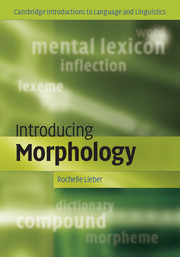Book contents
- Frontmatter
- Contents
- Preface
- The International Phonetic Alphabet
- Point and manner of articulation of English consonants and vowels
- 1 What is morphology?
- 2 Words, dictionaries, and the mental lexicon
- 3 Lexeme formation: the familiar
- 4 Productivity and creativity
- 5 Lexeme formation: further afield
- 6 Inflection
- 7 Typology
- 8 Words and sentences: the interface between morphology and syntax
- 9 Sounds and shapes: the interface between morphology and phonology
- 10 Theoretical challenges
- Glossary
- References
- Index
9 - Sounds and shapes: the interface between morphology and phonology
- Frontmatter
- Contents
- Preface
- The International Phonetic Alphabet
- Point and manner of articulation of English consonants and vowels
- 1 What is morphology?
- 2 Words, dictionaries, and the mental lexicon
- 3 Lexeme formation: the familiar
- 4 Productivity and creativity
- 5 Lexeme formation: further afield
- 6 Inflection
- 7 Typology
- 8 Words and sentences: the interface between morphology and syntax
- 9 Sounds and shapes: the interface between morphology and phonology
- 10 Theoretical challenges
- Glossary
- References
- Index
Summary
CHAPTER OUTLINE
In this chapter we will learn about the intersection between morphology and phonology, which is the study of the sound structure of languages.
We will learn that some morphemes exhibit allomorphs, that is, phonologically distinct variants.
We will learn how to analyze both phonologically predictable and unpredictable allomorphy.
And we will consider the nature of lexical stratification, where different types of phonological behavior characterize different parts of the morphology of a language.
KEY TERMS
allomorph, assimilation, dissimilation, vowel harmony, intervocalic, voicing, palatalization, lexical strata
Introduction
Phonology is the area of linguistics that is concerned with sound regularities in languages: what sounds exist in a language, how those sounds combine with each other into syllables and words, and how the prosody (stress, accent, tone, and so on) of a language works. Phonology interacts with morphology in a number of ways: morphemes may have two or more different phonological forms whose appearance may be completely or at least partly predictable. Some phonological rules apply when two or more morphemes are joined together. In some languages morphemes display different phonological behavior depending on whether they are native to the language or borrowed into it from some other language. In this chapter we will explore the various ways in which phonology interacts with morphology.
In this chapter we will frequently make use of phonetic transcriptions, so you may want to review the IPA before you begin reading it.
- Type
- Chapter
- Information
- Introducing Morphology , pp. 157 - 176Publisher: Cambridge University PressPrint publication year: 2009



